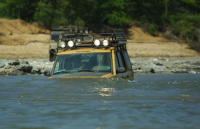- Joined
- Jun 25, 2012
- Messages
- 4,429
This TR documents a backpack down Poison Springs to the Dirty Devil and back out. Why Poison Springs given that it has a dirt road down it that even crosses the Devil and ascends out of the canyon on the other side to the east? I chose there because I had never been there and hoped that the road was obscure and untraveled (wrong) and because I had some new backpackers with me. The fact that the road was there was not all bad because there wasn't much traffic and it allowed us to drive part way down. This fact lured us into driving farther down the canyon when the weather turned rainy and that led to disaster. Fortunately the only thing that got hurt was my pride and my Tundra which was totaled. You'll see, keep reading.
I post this TR in the hopes of sharing the lessons I learned so you can keep from relearning them the same way.
So, the weather started pretty fine and we drove down a mile or two and parked in Poison Springs itself up on a little bench.
The first part of the canyon is not very deep but it is pretty. Hiking on a road is not my fave though...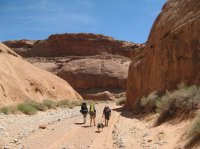
There is even a nice panel in the top part. Little Luna with her pack are in the pic too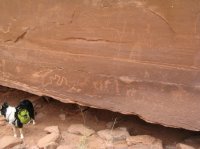
The lower part of the canyon.
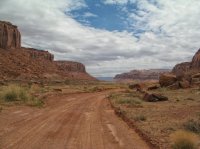
The lower part of the canyon has a feature called the Black Jump. It is a change in rock strata and color that causes another slot in the canyon. It is easy to poke your way down the drainage by traversing a short distance from the pourover. The road itself stays on the bench to the right and eventually goes down a side drainage. There is an old exploration road going to the left on the left bench above the Black Jump too that looked navigable.
The Black Jump (note the skies)
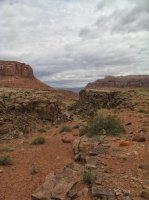
A great boulder with letterbox features
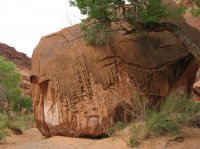
Turned out it was irresistible, as usual. If there is a way UP. One must always go up.
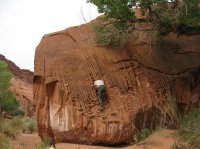
Here is the Dirty Devil itself. Crossing was easy albeit a little swift. Merlin and I had no problem. This hike was done in April to give you an idea of water flow. I thought it looked pretty easy to drive it. I wouldn't drive across alone. And I hadn't had the experience I had the next day. Now I am not so sure I would ever drive it
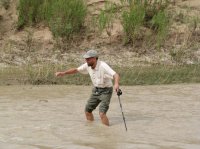
Two experienced river crossers
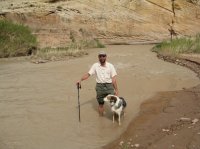
This canyon is very important as is the road because it allows the USGS to install and maintain the most important gaging station in the Dirty Devil drainage, bar none. This is the place to check before you go for the river flow. It is accessed here. This site shows you the Cubic Feet per Second (CFS) that the Devil is running at. A flow rate of water but it translates to depth of the river and the speed. Right now. Real time. Very important. Another post here at BCP details my crossing experience at various CFS as well as other people's experience.
The gaging station (you can see that it gets pretty beat up by flash floods)
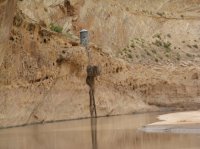
You can see the station in the lower left in the distance. I am standing on the road for this pic.
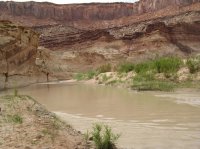
These USGS hydrologists are tough. The station is hard to get to even empty handed - not to mention with tools and equipment.
Poking our way down to the station
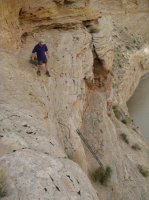
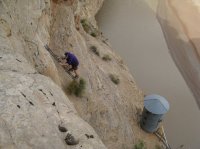
Some more views of the Devil from the bench above the Poison Springs/Dirty Devil confluence. (note the clouds now)
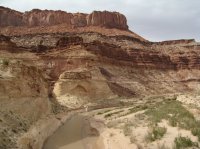
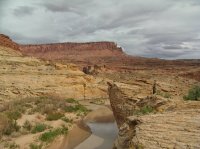
So, we walked back to the camp where we had parked the trucks and had a great evening. The next day we woke to a drizzle. Not too worried at that point since the canyon is very wide at most places and the stream was a trickle. Still we hustled breaking down camp immediately and started driving out. The road crosses the stream over and over again and in some places it is in the stream bed. As we crossed the stream depth went from 1" to 4" to 12" at successive crossing. I am driving my wife and two dogs in our Tundra and two trucks are following us - and it is still drizzling. We came around a corner and a section of the Poison Springs road was in the stream bed and the stream was flowing in it. I, charged up with adrenaline, pulled down into it and started up the stream bed and the two trucks behind me did the same. The water got deep quickly and started coming over the hood and then the windshield. Ruh Roh. I turned on the wipers (didn't help) and then stopped immediately and motioned the others backwards and up out of the stream which they completed uneventfully.
My forward motion gone I attempted to reverse and then again go forward to no avail and the engine died, forever. It had ingested water and hydrolocked. There wasn't much physical dangers since the stream bed was the only place there was water and there were wide benches next to it. We hustled the dogs and the packs out of the truck anyway thinking we might have to camp there since we might be stranded.
The water receded, down to ankle deep in less than an hour, and quite running an hour after that. Dang adrenaline! The truck was buried to the axles in mud, rocks and debris and it took us an hour of digging and roping up the other two trucks ahead of it, in series, to pull it out of the hole up to another bench presumably into safety. We learned later that it flashed again that day and the truck was at least axle deep in the second flood and some other locals lost their truck too that afternoon. A trip to Hanksville and meeting the great guy that owns the Sinclair there ended in arrangements for him to take his tractor and friend down to tow it out for a $1500 bill later that week. The insurance companies do not try and repair flooded vehicles because of lack of success in the past. They ended up totaling it and they covered the loss. We replace it with our Taco.
Poor, poor Tundra (phone pictures-sorry, this is after the water has gone down about a foot)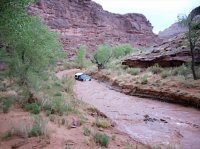
I really loved that truck!
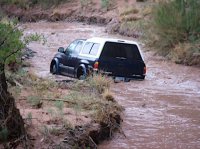
So, lessons learned:
1) When faced with a flash flood, don't rush it. Stay up on a bench where it is safe and don't drive (or walk) in it. You can't. And it is likely to subside very quickly anyway.
2) It is a good idea to have others with you. Being a soloist this sounds wrong coming from me but I would have had to spend hours walking my family out of there and hitchhiking to Hanksville if we hadn't had other trucks with us.
3) Even though we were never in any serious personal danger it was still pretty frightening. So, repeat #1 - don't drive or walk in it. Wait it out.
4) As you are walking or driving in a canyon have a contingency plan in process the whole way. Memorize ways out. Memorize benches to get up higher.
5) The flood came down from a side drainage from the north off the Burr Desert. Poison Springs wasn't even the origin. Once we drove up a couple of miles Poison Springs was bone dry. It had been drizzling on us but never a downpour. So, the source of the thunderstorm was quite a ways away. They are right when they say it could be decent sky over head and you could still get flashed. I did.
I heard later that another family of locals were stranded down Poison Springs by the afternoon flash flood and lost their truck too but without injury. The helpful Sinclair station owner said it happens to tourists and locals all the time. Anybody can get complacent or amped up enough to try driving it.
Mea culpa. There's my dirty laundry. Hope it helps. I wouldn't say I avoid the desert or canyons now because of the accident. In fact the canyons and potential floods maybe frighten me less now that I have been through an incident. But I learned these lessons and I am further awed by the power of our Mother Nature.
Go out there! ...safely....
Featured image for home page:
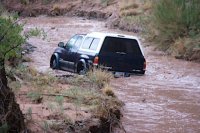
I post this TR in the hopes of sharing the lessons I learned so you can keep from relearning them the same way.
So, the weather started pretty fine and we drove down a mile or two and parked in Poison Springs itself up on a little bench.
The first part of the canyon is not very deep but it is pretty. Hiking on a road is not my fave though...

There is even a nice panel in the top part. Little Luna with her pack are in the pic too

The lower part of the canyon.

The lower part of the canyon has a feature called the Black Jump. It is a change in rock strata and color that causes another slot in the canyon. It is easy to poke your way down the drainage by traversing a short distance from the pourover. The road itself stays on the bench to the right and eventually goes down a side drainage. There is an old exploration road going to the left on the left bench above the Black Jump too that looked navigable.
The Black Jump (note the skies)

A great boulder with letterbox features

Turned out it was irresistible, as usual. If there is a way UP. One must always go up.

Here is the Dirty Devil itself. Crossing was easy albeit a little swift. Merlin and I had no problem. This hike was done in April to give you an idea of water flow. I thought it looked pretty easy to drive it. I wouldn't drive across alone. And I hadn't had the experience I had the next day. Now I am not so sure I would ever drive it

Two experienced river crossers

This canyon is very important as is the road because it allows the USGS to install and maintain the most important gaging station in the Dirty Devil drainage, bar none. This is the place to check before you go for the river flow. It is accessed here. This site shows you the Cubic Feet per Second (CFS) that the Devil is running at. A flow rate of water but it translates to depth of the river and the speed. Right now. Real time. Very important. Another post here at BCP details my crossing experience at various CFS as well as other people's experience.
The gaging station (you can see that it gets pretty beat up by flash floods)

You can see the station in the lower left in the distance. I am standing on the road for this pic.

These USGS hydrologists are tough. The station is hard to get to even empty handed - not to mention with tools and equipment.
Poking our way down to the station


Some more views of the Devil from the bench above the Poison Springs/Dirty Devil confluence. (note the clouds now)


So, we walked back to the camp where we had parked the trucks and had a great evening. The next day we woke to a drizzle. Not too worried at that point since the canyon is very wide at most places and the stream was a trickle. Still we hustled breaking down camp immediately and started driving out. The road crosses the stream over and over again and in some places it is in the stream bed. As we crossed the stream depth went from 1" to 4" to 12" at successive crossing. I am driving my wife and two dogs in our Tundra and two trucks are following us - and it is still drizzling. We came around a corner and a section of the Poison Springs road was in the stream bed and the stream was flowing in it. I, charged up with adrenaline, pulled down into it and started up the stream bed and the two trucks behind me did the same. The water got deep quickly and started coming over the hood and then the windshield. Ruh Roh. I turned on the wipers (didn't help) and then stopped immediately and motioned the others backwards and up out of the stream which they completed uneventfully.
My forward motion gone I attempted to reverse and then again go forward to no avail and the engine died, forever. It had ingested water and hydrolocked. There wasn't much physical dangers since the stream bed was the only place there was water and there were wide benches next to it. We hustled the dogs and the packs out of the truck anyway thinking we might have to camp there since we might be stranded.
The water receded, down to ankle deep in less than an hour, and quite running an hour after that. Dang adrenaline! The truck was buried to the axles in mud, rocks and debris and it took us an hour of digging and roping up the other two trucks ahead of it, in series, to pull it out of the hole up to another bench presumably into safety. We learned later that it flashed again that day and the truck was at least axle deep in the second flood and some other locals lost their truck too that afternoon. A trip to Hanksville and meeting the great guy that owns the Sinclair there ended in arrangements for him to take his tractor and friend down to tow it out for a $1500 bill later that week. The insurance companies do not try and repair flooded vehicles because of lack of success in the past. They ended up totaling it and they covered the loss. We replace it with our Taco.
Poor, poor Tundra (phone pictures-sorry, this is after the water has gone down about a foot)

I really loved that truck!

So, lessons learned:
1) When faced with a flash flood, don't rush it. Stay up on a bench where it is safe and don't drive (or walk) in it. You can't. And it is likely to subside very quickly anyway.
2) It is a good idea to have others with you. Being a soloist this sounds wrong coming from me but I would have had to spend hours walking my family out of there and hitchhiking to Hanksville if we hadn't had other trucks with us.
3) Even though we were never in any serious personal danger it was still pretty frightening. So, repeat #1 - don't drive or walk in it. Wait it out.
4) As you are walking or driving in a canyon have a contingency plan in process the whole way. Memorize ways out. Memorize benches to get up higher.
5) The flood came down from a side drainage from the north off the Burr Desert. Poison Springs wasn't even the origin. Once we drove up a couple of miles Poison Springs was bone dry. It had been drizzling on us but never a downpour. So, the source of the thunderstorm was quite a ways away. They are right when they say it could be decent sky over head and you could still get flashed. I did.
I heard later that another family of locals were stranded down Poison Springs by the afternoon flash flood and lost their truck too but without injury. The helpful Sinclair station owner said it happens to tourists and locals all the time. Anybody can get complacent or amped up enough to try driving it.
Mea culpa. There's my dirty laundry. Hope it helps. I wouldn't say I avoid the desert or canyons now because of the accident. In fact the canyons and potential floods maybe frighten me less now that I have been through an incident. But I learned these lessons and I am further awed by the power of our Mother Nature.
Go out there! ...safely....
Featured image for home page:


